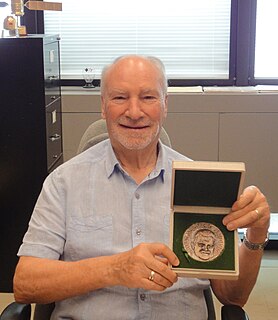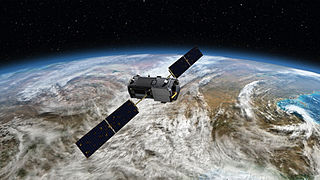Related Research Articles

The mesosphere is the third layer of the atmosphere, directly above the stratosphere and directly below the thermosphere. In the mesosphere, temperature decreases as altitude increases. This characteristic is used to define its limits: it begins at the top of the stratosphere, and ends at the mesopause, which is the coldest part of Earth's atmosphere with temperatures below −143 °C. The exact upper and lower boundaries of the mesosphere vary with latitude and with season, but the lower boundary is usually located at altitudes from 50 to 65 km above the Earth's surface and the upper boundary is usually around 85 to 100 km.
The mesopause is the point of minimum temperature at the boundary between the mesosphere and the thermosphere atmospheric regions. Due to the lack of solar heating and very strong radiative cooling from carbon dioxide, the mesosphere is the coldest region on Earth with temperatures as low as -100 °C. The altitude of the mesopause for many years was assumed to be at around 85 km (53 mi.), but observations to higher altitudes and modeling studies in the last 10 years have shown that in fact the mesopause consists of two minima - one at about 85 km and a stronger minimum at about 100 km (62 mi).

Radiative forcing or climate forcing is the difference between insolation (sunlight) absorbed by the Earth and energy radiated back to space. Changes to Earth's radiative equilibrium, that cause temperatures to rise or fall over decadal periods, are called climate forcings. Positive radiative forcing means Earth receives more incoming energy from sunlight than it radiates to space. This net gain of energy will cause warming. Conversely, negative radiative forcing means that Earth loses more energy to space than it receives from the sun, which produces cooling. A system in thermal equilibrium has zero radiative forcing.

Climate sensitivity is a measure of how much the Earth's climate will cool or warm after a change in the climate system, for instance, how much it will warm for doubling in carbon dioxide concentrations. In technical terms, climate sensitivity is the average change in the Earth's surface temperature in response to changes in radiative forcing, the difference between incoming and outgoing energy on Earth. Climate sensitivity is a key measure in climate science, and a focus area for climate scientists, who want to understand the ultimate consequences of anthroprogenic climate change.

Cluster II is a space mission of the European Space Agency, with NASA participation, to study the Earth's magnetosphere over the course of nearly two solar cycles. The mission is composed of four identical spacecraft flying in a tetrahedral formation. As a replacement for the original Cluster spacecraft which were lost in a launch failure in 1996, the four Cluster II spacecraft were successfully launched in pairs in July and August 2000 onboard two Soyuz-Fregat rockets from Baikonur, Kazakhstan. In February 2011, Cluster II celebrated 10 years of successful scientific operations in space. As of November 2018 its mission has been extended until the end of 2020 with a likely extension lasting until 2022. China National Space Administration/ESA Double Star mission operated alongside Cluster II from 2004 to 2007.

The atmosphere of Mars is the layer of gases surrounding Mars. It is primarily composed of carbon dioxide (95.32%), molecular nitrogen (2.6%) and argon (1.9%). It also contains trace levels of water vapor, oxygen, carbon monoxide, hydrogen and other noble gases. The atmosphere of Mars is much thinner than Earth's. The surface pressure is only about 610 pascals (0.088 psi) which is less than 1% of the Earth's value. The currently thin Martian atmosphere prohibits the existence of liquid water at the surface of Mars, but many studies suggest that the Martian atmosphere was much thicker in the past. The highest atmospheric density on Mars is equal to the density found 35 km above the Earth's surface. The atmosphere of Mars has been losing mass to space throughout history, and the leakage of gases still continues today.

The atmosphere of Uranus is composed primarily of hydrogen and helium. At depth it is significantly enriched in volatiles such as water, ammonia and methane. The opposite is true for the upper atmosphere, which contains very few gases heavier than hydrogen and helium due to its low temperature. Uranus's atmosphere is the coldest of all the planets, with its temperature reaching as low as 49 K.
The origin and development of water on terrestrial planets, Venus, Earth, Mars, and the closely related Earth's Moon, varies with each planetary body, with the exact origins remaining unclear. Additionally, the terrestrial dwarf planet Ceres is known to have water ice on its surface.

The Mars ocean hypothesis states that nearly a third of the surface of Mars was covered by an ocean of liquid water early in the planet’s geologic history. This primordial ocean, dubbed Paleo-Ocean and Oceanus Borealis, would have filled the basin Vastitas Borealis in the northern hemisphere, a region which lies 4–5 km below the mean planetary elevation, at a time period of approximately 4.1–3.8 billion years ago. Evidence for this ocean includes geographic features resembling ancient shorelines, and the chemical properties of the Martian soil and atmosphere. Early Mars would have required a denser atmosphere and warmer climate to allow liquid water to remain at the surface.

Climate change feedback is important in the understanding of global warming because feedback processes may amplify or diminish the effect of each climate forcing, and so play an important part in determining the climate sensitivity and future climate state. Feedback in general is the process in which changing one quantity changes a second quantity, and the change in the second quantity in turn changes the first. Positive feedback amplifies the change in the first quantity while negative feedback reduces it.

During past ages, there was rain and snow on Mars; especially in the Noachian and early Hesperian epochs. Some moisture entered the ground and formed aquifers. That is, the water went into the ground, seeped down until it reached a layer that would not allow it to penetrate, and then water piled up forming a layer that was saturated with water. Deep aquifers may still exist.

Theodore Gordon Shepherd FRS is the Grantham Professor of Climate Science at the University of Reading.

Gordon Greeley Shepherd is a Canadian space scientist, currently a Distinguished Research Professor Emeritus at York University

Space-based measurements of carbon dioxide are used to help answer questions about Earth's carbon cycle. There are a variety of active and planned instruments for measuring carbon dioxide in Earth's atmosphere from space. The first satellite mission designed to measure CO
2 was the Interferometric Monitor for Greenhouse Gases (IMG) on board the ADEOS I satellite in 1996. This mission lasted less than a year. Since then, additional space-based measurements have begun, including those from two high-precision satellites. Different instrument designs may reflect different primary missions.

Explorer 51, also called as AE-C, was a NASA scientific satellite belonging to series Atmosphere Explorer, being launched on December 16, 1973 from Vandenberg AFB board a Delta 1900 rocket.
John Clifford Bird is a Canadian engineer, scientist, and journalist. Bird’s research has included laser physics, atmospheric physics, and materials in microgravity. He broke the world altitude record for hang gliding by launching from a helium balloon at 35,000 ft, and spent a year at the Amundsen-Scott South Pole Station, which was documented in his book One Day, One Night: Portraits of the South Pole.
CICE is a computer model that simulates the growth, melt and movement of sea ice. It has been integrated into many coupled climate system models as well as global ocean and weather forecasting models and is often used as a tool in Arctic and Southern Ocean research. CICE development began in the mid-1990s by the United States Department of Energy (DOE), and it is currently maintained and developed by a group of institutions in North America and Europe known as the CICE Consortium. Its widespread use in earth system science in part owes to the importance of sea ice in determining Earth's planetary albedo, the strength of the global thermohaline circulation in the world's oceans, and in providing surface boundary conditions for atmospheric circulation models, since sea ice occupies a significant proportion (4-6%) of earth's surface. CICE is a type of cryospheric model.
Arlene M. Fiore is a professor at Columbia University and an atmospheric chemist whose research focuses on issues surrounding air quality and climate change.
Allison Steiner is a scientist who specializes in atmosphere-biosphere interactions, regional climate modeling, and chemistry climate interactions. Steiner has received countless awards for her contributions to the field, and was invited by the National Research Council and National Science Foundation to serve on a National Academies of Sciences, Engineering, and Medicine panel. She has also contributed to the geoscience community by founding the Earth Science Women’s Network, a non-profit organization that works to further the geosciences while also supporting and connecting women in the field.
Maura E. Hagan is a Professor of Physics and Dean of the College of Science at Utah State University. She is a Fellow of both the American Meteorological Society and the American Geophysical Union, and was elected a member of the National Academy of Sciences in 2019.
References
- 1 2 Liu, H.-L.; Foster, B. T.; Hagan, M. E.; McInerney, J. M.; Maute, A.; Qian, L.; Richmond, A. D.; Roble, R. G.; Solomon, S. C.; Garcia, R. R.; Kinnison, D. (2010). "Thermosphere extension of the Whole Atmosphere Community Climate Model". Journal of Geophysical Research: Space Physics. 115 (A12). doi:10.1029/2010JA015586. ISSN 2156-2202.
- ↑ Gettelman, A.; Mills, M. J.; Kinnison, D. E.; Garcia, R. R.; Smith, A. K.; Marsh, D. R.; Tilmes, S.; Vitt, F.; Bardeen, C. G.; McInerny, J.; Liu, H.-L. (2019). "The Whole Atmosphere Community Climate Model Version 6 (WACCM6)". Journal of Geophysical Research: Atmospheres. 124 (23): 12380–12403. doi: 10.1029/2019JD030943 . ISSN 2169-8996.
- ↑ "Whole Atmosphere Community Climate Model | National Center for Atmospheric Research". ncar.ucar.edu. Retrieved 2020-07-21.
| This article about climate change is a stub. You can help Wikipedia by expanding it. See guidelines for writing about Climate Change. Further suggestions might be found on the article's talk page. |